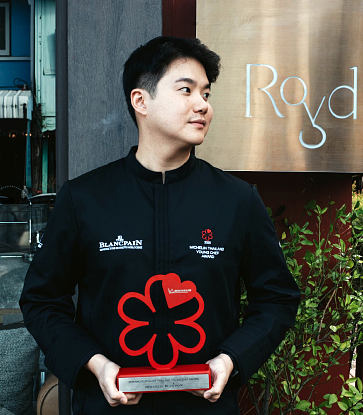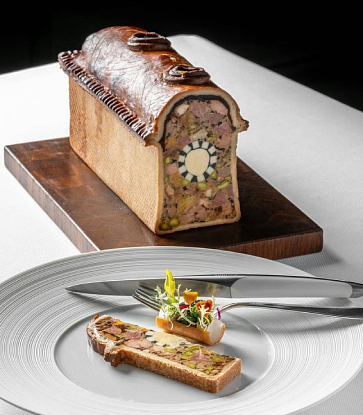When it comes to some of the most interesting flavours that permeate throughout Thailand’s myriad regional cuisines, there’s no doubt that the ubiquitous chilli pastes are far reaching. However, another popular star that magnificently reflects how the different regions’ foods blend into the others is none other than the rice noodle dish “khanom chin”.

Origin of khanom chin and what's in the name?
Khanom chin basically comprises round noodles made from rice flour served with a curry or sauce. Its definite origin is murky, but what is known is that it dates back to ancient times. Since chin means “Chinese” in Thai, some may think that it has something to do with the peoples who emigrated from China. However, one of the most popular theories is that khanom chin is not Chinese , but rather, from the Mon. In Mon, khanom chin is called “kanorm chin”, where “kanorm” means a pack sticking together and “chin” refers to being cooked. In Thai, the phrase “khao nom” means kneading rice flour into dough. It eventually shifted to “khanom”, meaning “snack”, which often is used to describe desserts, but this word is not just about sweet snacks like many may assume.
Historical writer and national literary artist, S. Plainoi states that there were old khlongs (canals) in Ayutthaya province named “Khlong Khanom Chin” and “Khlong Namya”, (“namya” being the sauce or curry served with khanom chin) which suggests that khanom chin has been available since well into the past.
“In ancient times, khanom chin was a main dish. When there were ceremonies and it was necessary to feed a lot of people, khanom chin was usually made due to its convenience when compared to other dishes. You simply put khanom chin in a bowl, pour curry over it. It is fuss-free because you just need a spoon to eat it. Initially, it is understood that there was only namya back then, as there was only a Khlong Namya in the historical records. There are no mentions of nam prik sauces yet. The Rattanakosin era may have had namya curries, but they did not have nam prik sauces like today. Not that I was born in time to know all this, but it can be deduced from reading historical letters, which solely mention khanom chin and namya but nothing else...”

No matter where you are, be it the Northern, Isan, Central, or Southern regions in Thailand, people from all enjoy khanom chin. In fact, every region has its own unique way of consuming this dish. Let’s have a look at the delicious khanom chin recipes served across the different regions.
The North
Originally, Northerners referred to khanom chin as “khao nom sen”. The three words eventually blended into “khanom sen” or even “khao sen” (rice strings) in some areas. They usually eat it with a curry called “nam ngiaw”, which stems from the Tai Yai culture. Nam ngiaw is made with pork-rib broth, tomatoes, and fermented beans. Some include the pork ribs, as well as minced pork and diced pork blood jelly. The most important ingredient that this curry cannot go without is “dok ngiaw”, a flower from the bombax ceiba tree. In the North, people usually like to have sides of bean sprouts, pickled vegetables, cabbage, chopped long beans, and pork cracklings to add texture to the dish.
Besides khanom chin with nam ngiaw, certain localities have their very own particular way of enjoying khanom chin. In the Long district of Phrae province, they have “khanom chin nam yoi”, fresh rice noodles with the nam yoi chilli paste. This paste consists of deep frying chilli, garlic, and shallots and then mixing it with seasonings to create a dry paste. Usually, it is consumed with boiled vegetables.

Isan, or Northeast
In Isan, khanom chin is locally referred to as “khao poon”. Isan people have placed khanom chin in pride of place, preparing it for merit and religious ceremonies— a long-running tradition passed down for generations. Since back in the day, villagers would come together to cook khao poon before a merit-making ceremony. This was one of the ways the community created unity and bonded together.
A signature curry of Isan is namya pah (jungle curry). Locally caught freshwater fish are usually included, such as snakehead fish, Thai carp, or catfish. Fresh chilli paste is pounded with aromatic herbs such as galangal, lemongrass, kaffir lime leaves, shallots, coriander, and dill. Then, it is seasoned with what is considered to be the soul of Isan food: fermented fish sauce. Also popular is the coconut milk chicken curry from Korat. Drop by any khanom chin restaurant in Isan, and they will most likely have these two staples. Besides those two favourites, there’s also a som tam made with khanom chin called “tum sua”. Various fresh local vegetables from the Isan region are served as a side with this dish, such as taew leaves, dill, rice paddy herb, and acacia leaves and seeds, among many others.

Central Thailand
There are a mind-boggling number of ways in which khanom chin is consumed in the Central region. Along with the obvious green curry, there is also fish in coconut milk curry. “Nam prik” is always an option, but this does not mean eating rice noodles with dips. It’s actually a thick sauce made from peanuts that leans towards the sweet side. A plethora of veggies also accompany khanom chin here, be it long beans, cucumber, chopped cabbage, bean sprouts, dill, bitter gourd, basil, pennywort, etc.

“Khanom chin sao nam” is another variety from the Central region. It has powdered dried shrimp, chopped garlic, shredded young ginger, and most importantly, juicy portions of pineapple and fish balls. It is topped with coconut milk and a touch of sugar. To season, diners can add a dash of chilli fish sauce and fresh lime to their preference. Sao nam is a popular go-to every time summer rolls around. In specific areas, such as Phetchaburi province, khanom chin is consumed even more particularly. There, they’ll eat the rice noodles with fish cakes, sprinkled with crispy basil leaves and a sweet and sour ajad sauce. This dish is called “khanom chin thod man”.

The South
The khanom chin culture in the South is very distinct with people eating it from early morning and throughout the day. The difference between the curries from the Central and Southern regions is that the Southern curries usually have cumin and a fiery palate. Besides the fish in coconut milk curry, another star from the South is crab curry with betel leaves. Fresh crabs from the sea make this a delightful curry, while the Southern fish curry is also another delicious go-to.
A handful of restaurants serve khanom chin for breakfast, with some offering patongko (fried dough) as a side. Beyond that, an interesting array of dishes that are enjoyed with khanom chin include batter-fried mushrooms or vegetables, fried chicken, and even steamed fish curry. Side veggies here are called “pak noh”, and you can imagine the impressive display that diners can choose from. Another dish you’ll find is “khanom chin nam soup”, where the noodles are topped with a kapi chilli paste.

Did you know this about khanom chin?
The original and authentic way to make khanom chin is to use fermented flour. The fermenting period lasts for a few days, giving the noodles a darker colour and slightly tangy taste. For this reason, eating khanom chin may give you an upset stomach. This is why many khanom chin curry recipes include fingerroot, which can help alleviate upset stomachs. As technology advanced, rice noodles became processed with fresh flour, even though it does not last as long as fermented flour.
The culture of khanom chin actually extends across Southeast Asia. Each region has its own take on khanom chin. In Vietnam, noodles similar to khanom chin are called “bun”. Cambodia calls theirs “nom banh chok”, whilst in Myanmar, “mohinga” is their version of rice noodles.

Fancy some khanom chin?
In the 2022 MICHELIN Guide Thailand, a number of khanom chin restaurants have been included, such as the Bib Gourmand recognised, Sanpakoi Kanomjeen in Chiang Mai. This eatery has been open since 1977 and offers five curries to choose from. Pick between chicken green curry, spicy pork or beef curry, nam ngiaw, and namya.
Down South, Phang-Nga province is home to another Bib Gourmand recipient, Khanom Chin Pa Son. Locals refer to this restaurant as “the khanom chin place in front of the shrine”. Open for over three decades, fresh rice noodles are served with a choice of four curries, namely namya, nam prik, fish curry, and jungle curry. You can also load your plate up to your heart’s content with over 20 sides, ranging from fresh vegetables, boiled eggs, as well as crispy fried fish. The options are truly endless though, because you can be sure to find delicious khanom chin at countless of other Thai restaurants in the guide too!





















